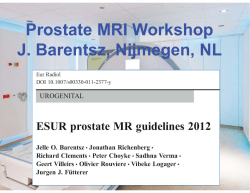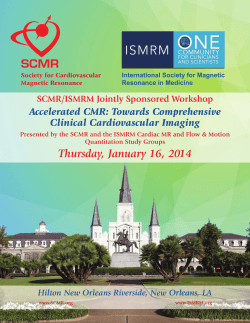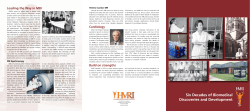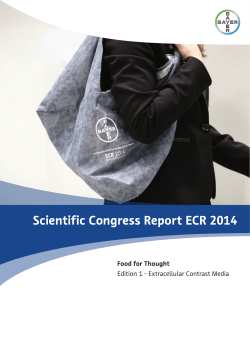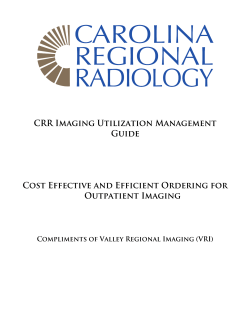
Prostate MRI: A Review of Current Knowledge and Literature Brian Rutt Charlie McKenzie
Prostate MRI: A Review of Current Knowledge and Literature Brian Rutt Charlie McKenzie July 18, 2007 Prostate MRI: A Review of Current Knowledge and Literature 20% 70% Copyright ©Radiological Society of North America, 2007 Prostate Anatomy Choi YJ et al, Radiographics 2007;27:63-75 MRI Techniques • • • • • Endorectal coil T2 weighted imaging Proton spectroscopy Diffusion weighted imaging DCE MRI MRI Techniques • • • • • Endorectal coil T2 weighted imaging Proton spectroscopy Diffusion weighted imaging DCE MRI QuickTime™ and a TIFF (LZW) decompressor are needed to see this picture. Rigid Endorectal Coil Endorectal Coil (Medrad) Endorectal Coil Heijmink et al, Radiology 2007;244:184-195 Endorectal Coil Heijmink et al, Radiology 2007;244:184-195 Endorectal Coil MRI MR image quality of the prostate improves significantly with the use of an erCoil For prostate cancer localization, performance with erCoil MR imaging was significantly better than was that with external array MR imaging erCoil is necessary for accurate localization and staging of prostate cancer Heijmink et al, Radiology 2007;244:184-195 MRI Techniques • • • • • Endorectal coil T2 weighted imaging Proton spectroscopy Diffusion weighted imaging DCE MRI T2 Weighted Endorectal Coil MRI Choi YJ et al, Radiographics 2007;27:63-75 T2 Weighted Endorectal Coil MRI T2-weighted MRI has significant limitations for depicting cancer in the transitional and central zones: • cancer and normal tissues both have low signal intensity on T2-weighted images In addition, low signal intensity may be seen in the peripheral zone on T2-weighted images in the presence of many noncancerous abnormal conditions Choi YJ et al, Radiographics 2007;27:63-75 T2 Weighted Endorectal Coil MRI At 1.5T, sensitivity of 77%–91% and specificity of 27%–61% have been reported for prostate cancer detection with T2w MRI using erCoil At 3T, these numbers may increase substantially Choi YJ et al, Radiographics 2007;27:63-75 3T T2w Endorectal Coil MRI accuracy 94%, sensitivity 88%, specificity 96% Image courtesy of JO Barentsz MRI Techniques • • • • • Endorectal coil T2 weighted imaging Proton spectroscopy Diffusion weighted imaging DCE MRI MR Spectroscopy Choi YJ et al, Radiographics 2007;27:63-75 MRS (Cho+Cr/Citrate) Correlates with Gleason Grade • • • limited to PZ 29 of 123 patients excluded patients with prostatitis excluded Zakian KL, Radiology 2005 ACRIN 6659 MRI and MRSI of Prostate Cancer Prior to Radical Prostatectomy: A Prospective Multi-Institutional Clinicopathological Study PI: Co-PI: Spectroscopy Advisor Pathology Advisor Statistical Advisor Biostatistician Lead Data Manager Jeffrey Weinreb, MD Fergus Coakley MB BCh John Kurhanewicz PhD Thomas Wheeler MD Jeffrey Blume PhD Jean Cormack PhD Karen Boparai RT Mem Sloan Kettering CC Scott Gerst U Texas MD Anderson CC Haesun Choi Mayo Clinic Rochester Akira Kawashima U Pennsylvania Med Ctr Mark Rosen Brigham and Women’s Hosp Clare Tempany Johns Hopkins U Katarzyna Macura ACRIN Staff Supported by NCI Grants U01 #CA079778 &#CA80098 Technical Assistance from GE Healthcare Endorectal Coils provided by MEDRAD Preliminary Results of ACRIN Trial • Satisfactory quality erCoil MRI and MRSI were obtained from all sites, although MRSI was more consistently of higher quality at some • Both MRI and MRI+MRSI performed significantly better for tumors based on • • • • Size (> 10mm) Volume (> 0.5cc) Gleason Score (> 7) Location (midgland best) • All readers had same AUC for both MRI and MRI+MRSI Overall there was no incremental benefit for MRI+MRSI compared with MRI alone MR Spectroscopy Advantages of MR spectroscopy: • generally accepted accuracy • capability for depicting possible cancer in the transitional zone Disadvantages of MR spectroscopy: • long acquisition time • variability due to postprocessing or shimming • no direct visualization of the periprostatic anatomy • uncertain benefit on top of modern MRI alone MRI Techniques • • • • • Endorectal coil T2 weighted imaging Proton spectroscopy Diffusion weighted imaging DCE MRI T2 ADC Map Peripheral zone tumors Geometric mean diameter >=4mm Haider, van der Kwast, Evans, Trachtenberg et al Medical Imaging – Princess Margaret Hospital – University Health Network – Mount Sinai Hospital – University of Toronto Peripheral Zone n=49 T2 T2+DWI Sensitivity 73/127 (58) 111/127 (87) Specificity 152/167 (91) 134/167 (80) PPV 73/88 (83) 111/144 (77) NPV 152/206 (74) 134/150 (89) Accuracy 225/294 (77) 245/294 (83) Haider, van der Kwast, Evans, Trachtenberg et al Medical Imaging – Princess Margaret Hospital – University Health Network – Mount Sinai Hospital – University of Toronto Diffusion Weighted MRI Advantages: • significant differences in the mean ADC values between cancerous and normal tissues, • DWI may provide an incremental diagnostic accuracy increase over T2w MRI alone Disadvantages • individual variability decreases the diagnostic accuracy of ADC measurement for prostate cancer detection and localization MRI Techniques • • • • • Endorectal coil T2 weighted imaging Proton spectroscopy Diffusion weighted imaging Dynamic Contrast Enhanced MRI DCE MRI of Cancer Relative SI vs Tim e 1 0.9 0.8 0.7 0.6 0.5 0.4 0.3 0.2 0.1 0 0 100 200 300 400 500 s Choi YJ et al, Radiographics 2007;27:63-75 T2w vs MRS vs DCE MRI n=34 T2 MRS DCEMRI Sensitivity 52-67 77-80 84-85 Specificity 73-74 84-87 83-88 PPV 38-43 64-68 61-70 NPV 83-88 91-93 94-95 Accuracy 69-71 82-85 83-87 Tumors >0.5cc JJ Futterer et al, Radiology 2006;241:449-458 DCE MRI Advantages: • direct depiction of tumor vascularity • may obviate the use of endorectal coil Disadvantages: • unsatisfactory depiction of transitional zone cancer in patients with hypervascular benign prostatic hyperplasia • no consensus with regard to the best acquisition protocol and the optimal perfusion parameter for differentiating cancer from normal tissue Overall Status: Prostate MRI • Various MR imaging techniques can provide improved cancer detection and localization, as well as information regarding the biologic behavior, volume, and staging of cancers for individualized therapy • However, each technique has one or more limitations, such as no standard parameters, or low accuracy in the central region of the gland • No randomized large study has been performed to compare the techniques, and there has been no report with regard to which technique is best in a specific clinical situation MRI of Prostate MRI of Prostate QuickTime™ and a TIFF (LZW) decompressor are needed to see this picture. QuickTime™ and a TIFF (LZW) decompressor are needed to see this picture. Rigid Endorectal Coil T2-Weighted Images Villeirs et. al. Radiotherapy and Oncology 76 (2005) 99. Review of Recent Prostate MR Literature • ISMRM 2006 Abstracts • ISMRM 2007 Abstracts • Recent papers Overview of ISMRM 2006 Abstracts: • Coils (#113, 170, 171, 176, 1757, 2593): 1. Endorectal Coils: – Less sensitive to motion artifacts – Require much more time for positioning – Require medical expertise to position – May require pharmaceutical intervention for bowel/anal preparation – More sensitive to susceptibility artifacts – Higher SNR Overview of ISMRM 2006 Abstracts: • Coils (#109, 172, 176, 1802): 1. Endorectal Coils: – Several groups reported inflating these coils with perfluorocarbons - reductions in artifacts. – One group inflated with barium - similar reductions in artifacts Overview of ISMRM 2006 Abstracts: • Coils: 2. Surface Coils: – More sensitive to motion artifacts – Better tolerance by patients – Easier to position – No pharmaceutical intervention required – Less sensitive to susceptibility artifacts Overview of ISMRM 2006 Abstracts: • Coils (#109, 170, 1757): QuickTime™ and a TIFF (LZW) decompressor are needed to see this picture. 2. Surface Coils: – Many of the studies at 3T were concerned with showing that endorectal coils were not necessary at higher field strength – General Consensus: increased SNR at 3T counters the loss of SNR of surface coils Abstract #170 Overview of ISMRM 2006 Abstracts: • Imaging Methods: – Consensus (#109, 116, 1760): At least two of the following imaging methods required for reasonable sensitivity and specificity: • T2, DWI, DTI, DCEMRI, MRSI – There was no comparison of all these methods. – T2 found to vary in normal PZ over time. (Abstract #3335) Overview of ISMRM 2006 Abstracts: • Diffusion Weighted Imaging (#87, 114, 174, 178, 1615, 2246-9, 3330, 3338, 3343, 3485) – No standard diffusion parameters used. – ADC improves sensitivity/specificity, but not enough to use ADC alone QuickTime™ and a TIFF (LZW) decompressor are needed to see this picture. Abstract #2248 Overview of ISMRM 2006 Abstracts: • Diffusion Tensor Imaging – FA and RA in PZ and CG show some promise for diagnosing – No consensus! – DTI in prostate seems to be in its infancy! Abstract #174 Review of Recent Prostate MR Literature • ISMRM 2006 Abstracts • ISMRM 2007 Abstracts • Recent papers Summary of ISMRM 2007 Abstracts • Statistics: – Total of 58 abstracts read – – – – 7 abstracts used animals, 5 used human biopsies ex vivo, 1 examined brachy seeds only remainder (45) were human in vivo Summary of ISMRM 2007 Abstracts • Animal studies: – field strengths of 4.7T, 7T, 3T, 500MHz – Topics covered: • Vascular and metastatic characteristics dependent on tumour implantation site • Measurement of tumour volume and/or metabolite concentrations using MRI/MRSI • Affects of ADT on metabolites • Different perfusion characteristics of different sized contrast agents Summary of ISMRM 2007 Abstracts • Biopsies: – All 5 abstracts used magic angle spinning – Topics covered: • Used TOCSY to resolve overlapping cholinecontaining compounds and ethanolamine • Identified a previously unknown polyunsaturated fatty acid as linoleic acid found only in cancer • Elevation of all peaks associated with cholinecontaining compounds, lactate, and alanine were elevated in cancer • Post-radiation tissues (healthy and cancer) have lower concentrations of citrate and polyamines than untreated. Summary of ISMRM 2007 Abstracts • Human - Field Strengths – – – – 1 study at 7T 12 studies at 3T 27 studies at 1.5T 5 studies don’t specify, but it’s safe to assume that they were at 1.5T – There were no studies comparing 1.5T to 3T, unlike last year’s abstracts! Summary of ISMRM 2007 Abstracts • Human - Coils – 22 studies used endorectal coils (4 of these were at 3T) – 11 studies used non-endorectal coils - typically phased array coils (6 of these were at 3T, 1 was at 7T) – 1 study compared endorectal to phased array (all at 1.5T) - showed that SNR is higher with endorectal – 11 didn’t specify, but most likely endorectal (2 of these were at 3T) Summary of ISMRM 2007 Abstracts • Human - Gold Standard – 13 studies used whole mount/step section – 2 studies used transurethral resection (TURP) – 16 used biopsy only – 13 studies either used no gold standard or did not state use of a gold standard Summary of ISMRM 2007 Abstracts • Human - Summary of Themes Covered 1. Developing methods for comparing images to pathology: • • Using morphing techniques to register the histopathology to the MR images Scanned whole prostate in vivo and ex vivo and then matched these to pathology 2. Characterising affects of anti-androgen therapy and chemotherapy • • Differences in ADC, metabolite peaks after ADT ADC’s different in tumours that respond to chemo than those that don’t respond Summary of ISMRM 2007 Abstracts • Human - Summary of Themes Covered 3. Determination of cut-off values for ADC and metabolite concentrations that can be used to separate normal from benign from malignant • Despite these attempts, there’s still a lot of overlap 4. Testing of various MR methods (ADC, T2) for better diagnosis of difficult to diagnose cases (eg. Patients with intermediate PSA’s or those with repeated negative biopsies, BPH) Summary of ISMRM 2007 Abstracts • Human - Summary of Themes Covered 5. “Odds and Ends” • • • • • Implementation of CPMG instead of FSE to avoid PSF artifacts in FSE Comparison of contrast images, ADC, FA, T2 to Gleason score, PSA levels Improved quantitation of spectra using modeling 3D reconstruction of prostate to assist robotic biopsy Improved saturation of signal from outside prostate to reduce lipid contamination in spectra Summary of ISMRM 2007 Abstracts • Human - General Comments – There are a number of studies examining DWI, DTI, DCE MRI. While they may have slightly different methods than previously published results, their results are not significantly better. – Summarising these abstracts is quite difficult this year because it is obviously a field in its infancy (no general consensus for direction that the research should go, many topics covered), but there is much interest! Summary of ISMRM 2007 Abstracts • Human - General Comments – The debate about whether to use endorectal coils or other coils at higher fields only appeared in one abstract, although comments were made in other abstracts. General consensus seems to be that it would be nice to avoid endorectal, but it’s hard to give up the SNR! ISMRM 2007 Abstracts • Registration of MR images to Pathology (Morgan, et al, deSouza) – Pathologist defined ROIs – Morphing algorithm used to warp histopathology to picture of fresh specimen and then to T2 image. – Pathologist defined ROI could be applied to DW images. ISMRM 2007 Abstracts • Spectroscopy (Tessem et al. Kurhanewicz) – Malignancy associated with glycolytic flux (production of lactate and alanine) – Significant increases in lactate and alanine in tumours – Implications for hyperpolarised 13C imaging with pyruvate (pyruvate lactate and alanine) Review of Recent Prostate MR Literature • ISMRM 2006 Abstracts • ISMRM 2007 Abstracts • Recent papers Overview of Papers - Reviews: • “Teaching Moment” – Carroll, Coakley, Kurhanewicz. Rev Urol. 2006;8(suppl 1):S4. • Choline and Creatine are elevated in cancer • Citrate is reduced • [(Choline + Creatine) / Citrate] is diagnostic Overview of Papers - Reviews: • Carroll, Coakley, Kurhanewicz. Rev Urol. 2006;8(suppl 1):S4. Hricak Abdom Imaging 2006;31:182 – MRI and MRSI: • • • Tumour diameter >0.5cm for reasonable accuracy. Assessment of SVI: sensitivity = 20% - 80%, specificity = 92% - 98% Inability to distinguish normal from malignant after androgen deprivation or radiation therapy – Anatomy Assessed by Endorectal MRI: • “In general, most agree that gadolinium enhancement is not helpful for either prostate cancer localization or staging. However, the development and use of macromolecular contrast media may prove useful in the future.” Overview of Papers - Reviews: • Carroll, Coakley, Kurhanewicz. Rev Urol. 2006;8(suppl 1):S4. Hricak Abdom Imaging 2006;31:182 – Imaging for lymph Node Metastases: • • CT and MRI: sensitivity=36%, specificity=97% Super-paramagnetic nanoparticles show promise – Future Directions: • • • • Use of high field strengths Novel spectroscopic markers (polyamines, spermine) MRI-guided biopsy and treatment Use of molecular probes Overview of Papers - Coils: • • • • Torricelli et al. J Comput Assist Tomogr. 2006;30(3):355. Purpose: Compare 1.5T endorectal to 3T 6-channel external phased array cardiac receiver coil. Images ranked by 2 radiologists according to image quality and diagnostic accuracy Conclusion: “… the image quality provided by 3T MRI is almost the same yielded by erMRI, without the patient discomfort and the costs related to the endorectal device.” Overview of Papers - DCE and DWI: • • Kozlowski et. al. JMRI 24:108 (2006) Hypothesis: DCE and DWI combined provide higher diagnostic sensitivity than each technique alone Imaging Technique Sensitivity Specificity ADC 54% 100% DCE 59% 74% ADC + DCE 87% 74% Overview of Papers - DWI: • • Pickles et. al. JMRI 23:130 (2006) Purpose: Use ADC to distinguish normal tissue and tumours in PZ and CG at 3T. Overview of Papers - DTI: • • Gibbs et. al. Investigative Radiology 41(2):185 (2006) Purpose: Compare DWI and DTI in tumours and normal tissue at 3T using torso phased-array coil and parallel imaging. • Using a cut-off of 1.45x10-3mm2/s for mean diffusivity: Sensitivity = 84%, Specificity = 80% Overview of Papers - Spectroscopy: • • • Hom et al Kurhanewicz. Radiology 238(1):192 (2006) Fact: MRI/S abnormalities may not be clearly demarcated and often merge gradually into areas of normal peripheral zone T2 or metabolism Purpose: To establish size criteria for true-positive MRI/S assessment. QuickTime™ and a TIFF (LZW) decompressor are needed to see this picture. • Example: Tumour diameter on MR = 13mm, on Pathology = 2mm Conclusion: If MR determined transverse diameter is >2x pathology diameter, tumour should be considered chance-detected. Overview of Papers - Non-PZ Cancer: • • Akin et al Hricak. Radiology 239(3):784 (2006) Purpose: To assess T2 MRI for diagnosis of TZ tumours. Considered: 1) homogeneity of T2 SI, 2) ill-defined margins; 3) lack of capsule; 4) lenticular shape; 5) invasion of anterior fibromuscular stroma BPH • • TZ Cancer Sala et al Hricak. Radiology 238(3):929 (2006) Purpose: To assess MRI for diagnosis of SVI. Factors best predictive of SVI: 1) Tumour at base that extends beyond capsule; 2) low signal intensity within SV; 3) loss of normal architecture. Staging Detection Medical Imaging – Princess Margaret Hospital – University Health Network – Mount Sinai Hospital – University of Toronto MRI Techniques • • • • • • • • Endorectal coil T2 weighted imaging 3T Ferumoxtran-10 Proton spectroscopy Diffusion weighted imaging DCE MRI T2* (“BOLD”) MRI Medical Imaging – Princess Margaret Hospital – University Health Network – Mount Sinai Hospital – University of Toronto Ferumoxtran-10 • • • • Combidex, Sinerem, AMI-7227, AMI-227, BMS 180549 iron oxide crystalline core 4-6 nm covered by low molecular weight dextran (30nm) Phase III trials still underway NOT APPROVED AGENT Prostate Cancer n=80 patients Sensitivity Specificity NPV Accuracy PPV Size 45 78 67 65 60 USPIO 100 96 100 98 94 Prognostication Patient Specific Therapy Modulation Nodes 5-10mm Sensitivity 29% vs 96% Nodes <5mm Sensitivity 0% vs 41% p<0.001 Harisinghani et al NEJM 2003 Node Mapping for IMRT Staging - Summary • • • erMRI is useful for staging patients at high risk of extraprostatic disease extension (ECD) and likely intermediate risk as well erMRI is not indicated for staging patients with low risk of ECD In the future Ferumoxtran-10 may play an important role in nodal assessment for prognostication and patient tailored therapy modulation (IMRT or LND) Medical Imaging – Princess Margaret Hospital – University Health Network – Mount Sinai Hospital – University of Toronto Staging Detection Medical Imaging – Princess Margaret Hospital – University Health Network – Mount Sinai Hospital – University of Toronto Prostate Cancer Detection PSA Surgery or Rads Cancer Microfocus cancer TRUS Bx HGPIN/ASAP Normal MRI aided TRUS biopsy localization Medical Imaging – Princess Margaret Hospital – University Health Network – Mount Sinai Hospital – University of Toronto Detection - Summary • Further study is needed • Tumors under 0.2cc are poorly detected • There may be a role for MRI in patients at high risk with 2 prior negative TRUS biopsies for localization • MRI should be considered in studies involving minimally invasive therapies Medical Imaging – Princess Margaret Hospital – University Health Network – Mount Sinai Hospital – University of Toronto
© Copyright 2025


